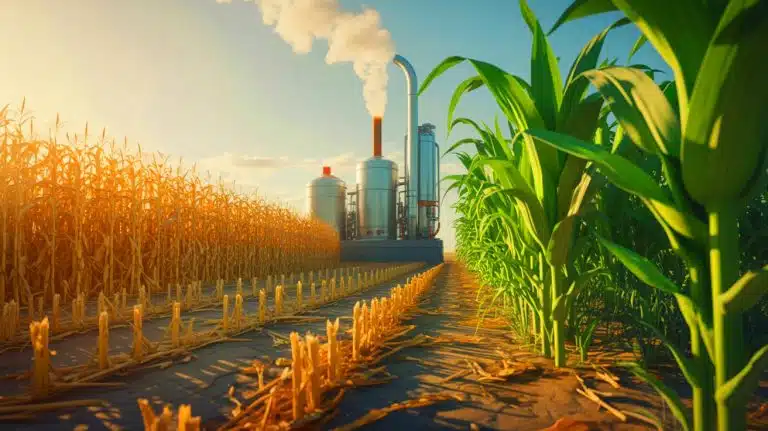| IN A NUTSHELL |
|
Amid escalating climate challenges, innovative solutions are emerging from unexpected quarters. One such development involves the reimagining of corn residues as potential climate allies. The United States, a leading global producer of corn, harvests approximately 350 million tons annually. Post-harvest, these fields are often littered with leftover stalks. However, researchers at Iowa State University propose a groundbreaking method to transform these remnants into an environmentally beneficial resource. By converting agricultural waste into a special vegetable oil, capable of trapping CO₂ in abandoned oil wells, they aim to mitigate climate change impacts. This approach presents a promising, sustainable alternative to conventional carbon capture methods.
Corn’s Role in Carbon Sequestration
During its growth, corn absorbs carbon dioxide (CO₂) from the atmosphere, storing it in its stalks, leaves, and ears. Post-harvest, when these remains decompose, the stored carbon is released back as CO₂, negating the benefits of the carbon capture during growth. To counter this, Professor Mark Mba-Wright and his team propose a process known as rapid pyrolysis. This method involves heating the biomass in an oxygen-free environment, preventing it from burning. The result is three products: a biochar that enhances soil fertility, a gas that fuels the pyrolysis reactor, and a dense bio-oil rich in carbon.
Injecting this bio-oil into abandoned oil wells offers a long-term carbon storage solution. The oil remains underground for centuries, reversing the carbon cycle by returning the absorbed carbon back to where it was originally extracted as fossil fuels. This innovative approach not only prevents atmospheric saturation but also repurposes defunct wells. As Mba-Wright articulates, this dual-purpose solution utilizes unused plant waste while addressing the pressing need to seal abandoned oil wells.
Advantages of Bio-Oil Over Conventional Methods
The United States has approximately 120,000 documented orphaned oil wells, with estimates suggesting the presence of hundreds of thousands more. These wells often emit methane, a greenhouse gas significantly more potent than CO₂. Over 100 years, methane’s warming potential is 28 times greater than CO₂, surging to 84 times over 20 years. Filling these wells with bio-oil tackles two issues: sealing the wells and sequestering carbon permanently. The cost of this sequestration, estimated at $152 per ton of CO₂, is competitive with Direct Air Capture (DAC) technologies but without their extensive infrastructure needs.
Proponents suggest deploying mobile pyrolysis units at farm sites to convert agricultural waste into bio-oil. This decentralization reduces costs and enhances accessibility. Peter Reinhardt, CEO of Charm Industrial, emphasizes the reliability and cost-effectiveness of bio-oil sequestration. Furthermore, the resultant biochar improves local soil quality, enhancing water retention and nutrient absorption, thereby boosting agricultural yields.
Challenges and Future Prospects
Despite its promise, the bio-oil sequestration method remains experimental. Mba-Wright acknowledges the hurdles ahead in scaling this process for commercial use. If successful, this low-tech carbon sequestration approach could be a viable solution. However, addressing the global climate crisis demands systemic changes beyond carbon capture. The root issue lies in the global economy’s reliance on inexpensive, carbon-intensive energy sources. Without addressing this dependency, methods like bio-oil sequestration will merely serve as temporary solutions to a far-reaching problem.
Researchers continue to test converting agricultural and forestry residues into carbon-rich oil for permanent burial. This method rivals the costs of direct CO₂ capture technologies but with smaller, less expensive, decentralized installations. Additionally, it offers local benefits like soil improvement, supplemental farmer income, and enhanced well safety. As with any novel approach, there are challenges and uncertainties to overcome.
Local and Global Implications
Beyond the technical aspects, the adoption of bio-oil sequestration has significant socio-economic implications. It provides farmers with additional revenue streams and promotes sustainable agricultural practices. Enhanced soil quality through biochar use can lead to increased agricultural productivity, benefiting local economies. This approach also emphasizes the importance of local solutions for global problems, highlighting how agricultural waste can be transformed into a resource.
On a broader scale, the success of such methods could inspire similar initiatives worldwide. By turning waste into a valuable asset, communities can contribute meaningfully to global climate goals. Yet, this innovative approach must be part of a larger strategy, integrating various solutions to effectively combat climate change.
As the world grapples with climate change, innovative solutions like bio-oil sequestration offer hope. However, the path to widespread adoption and effectiveness is lined with challenges. How can the global community integrate such innovative approaches with comprehensive strategies to tackle the broader issue of carbon emissions?
Did you like it? 4.5/5 (22)








Wow, this is fascinating! How long does it take for the bio-oil to be injected into wells? 🤔
Wow, turning corn stalks into carbon prisons? That’s some sci-fi stuff! 🌽🔬